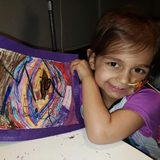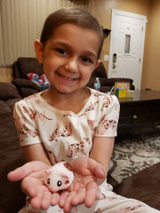Beta Thalassemia Major: Mia’s Story
Beta Thalassemia Major: Mia’s Story
When Mia was 3 years old, her parents, Diane and Lou, watched with growing sadness as each of Mia’s monthly medical appointments approached. “She developed anxiety, which started days before our appointment,” says Diane of her daughter. Mia had been born with a rare blood disease that required regular, difficult blood transfusions. When the family faced the possibility of a procedure to cure Mia, “You think it would have been a no brainer,” says Diane, but the procedure involved a small but life-threatening amount of risk. The family found solace and answers at Children's Hospital of Philadelphia (CHOP).

When Diane was pregnant, an amniocentesis revealed that the baby had beta thalassemia major, an inherited condition that affects hemoglobin, a protein in the red blood cells that is responsible for carrying oxygen throughout the body. “After researching the disorder and finding a specialist for when she was born, I thought I was pretty well educated and prepared,” says Diane. But at Mia’s two-and-a-half-month checkup with the hematologist in New York, the reality set in. Mia’s hemoglobin was low and she required her first blood transfusion.
‘Full of heartache’
More About Beta Thalassemia
The transfusions needed to happen every few weeks, and they were heart-wrenching for Diane and Lou. As an infant, Mia’s veins were tiny, so she needed to be sedated to place an IV line. “I was a new mom, overwhelmed, stressed, full of heartache and fear,” says Diane. “Doctors assured me it would get easier as she got older when her veins would be bigger.” They said that the whole family would come to regard these procedures as the new normal way of life.
But instead, Mia began dreading the procedure. During the car ride from their home on Staten Island, N.Y., to the doctor in Manhattan, Mia would start vomiting. As she got smarter and older, she asked more questions. She became sad about missing school for the daylong procedure, and she began feeling that her need for blood made her different. That need would remain for her entire life.
“I always tried to make those days ‘no big deal,’” says Diane, “and I never let her see me cry, but the truth is I felt physically pained.” So they began considering the potential cure that is available: bone marrow transplantation (BMT). The procedure replaces the patient’s bone marrow with marrow from a donor that correctly produces hemoglobin. The success rate is very high, but for a tiny percentage, the procedure is fatal.
Hope mixed with fear

After two years of trying, Diane became pregnant and gave birth to a boy they named John. He was Mia’s perfect match to be a donor. John’s umbilical cord blood was saved to be used if Mia underwent the bone marrow transplant. “All that we had hoped for was here staring right us,” says Diane of John. And yet, she and Lou hesitated. As Diane puts it, “This involved some risk to Mia. This involved the ‘choice’ to give our daughter chemotherapy,” which Mia would need prior to the BMT to clear out the existing bone marrow and “make space” for the new marrow.
The decision was agonizing. They wanted a second consultation, and came to CHOP, where they met Tim Olson, MD, PhD. “It wasn’t until I met Dr. Olson that I was able to process my thoughts and have confidence that this was ultimately the best thing for Mia,” says Diane. “The approach was different than what I have previously heard, and he was patient and empathic when answering my questions and hearing my fears.”
In August 2019, when Mia was 6, the family began preparing for the BMT. Mia knew that there was something about her brother’s blood that could cure her disease. “She was excited to think she might no longer need blood for the rest of her life,” says Diane. But Mia was upset to find out she needed to stay at CHOP for several weeks and would miss the beginning of first grade.
100% donor cells

Mia was admitted to the hospital for her transplant. She underwent chemotherapy and remained in isolation for nearly five weeks, because her immune system was compromised. The BMT happened in October, first with John undergoing surgery to collect his stem cells, which were then administered to Mia, followed by his cord blood.
After her brother’s stem cells restored her blood counts, Mia was discharged in early November, and she and Diane began living at the Philadelphia Ronald McDonald House, on a floor with special precautions for patients with weak immune systems. A few weeks later, it was determined that Mia’s blood consisted of 100% donor cells.
Months later and after returning home, the family remains vigilant to make sure Mia and John don’t get exposed to anything that could cause an infection. “Neither one of my kids goes anywhere,” says Diane. “I myself can probably count five times I’ve gone to a store.” But that’s a small price to pay, and Diane remains astonished at Mia’s new reality: “You think the day is going to come when she’s going to need blood. But then a month goes by. And another. And she doesn’t need blood!”